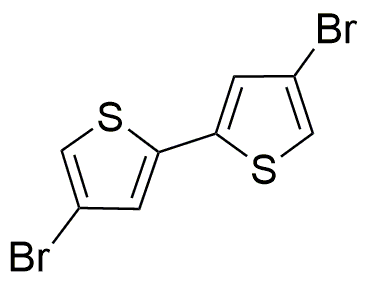4,4'-Dibromo-2,2'-bithiophene is widely utilized in research focused on:
- Organic Electronics: This compound is a key material in organic semiconductors, particularly in the development of organic photovoltaic cells and organic light-emitting diodes (OLEDs), enhancing energy efficiency and performance.
- Conductive Polymers: It serves as a building block for synthesizing conductive polymers, which are essential in flexible electronics and wearable technology, providing lightweight and adaptable solutions.
- Sensor Technology: The compound is used in the fabrication of chemical sensors and biosensors, benefiting industries like environmental monitoring and healthcare by enabling sensitive detection of various analytes.
- Material Science: In material science, it contributes to the creation of advanced materials with tailored electronic properties, useful in applications such as batteries and supercapacitors, offering improved energy storage capabilities.
- Research and Development: It is frequently employed in academic and industrial research to explore new applications in organic synthesis and materials science, driving innovation in various fields.
General Information
Properties
Safety and Regulations
Applications
4,4'-Dibromo-2,2'-bithiophene is widely utilized in research focused on:
- Organic Electronics: This compound is a key material in organic semiconductors, particularly in the development of organic photovoltaic cells and organic light-emitting diodes (OLEDs), enhancing energy efficiency and performance.
- Conductive Polymers: It serves as a building block for synthesizing conductive polymers, which are essential in flexible electronics and wearable technology, providing lightweight and adaptable solutions.
- Sensor Technology: The compound is used in the fabrication of chemical sensors and biosensors, benefiting industries like environmental monitoring and healthcare by enabling sensitive detection of various analytes.
- Material Science: In material science, it contributes to the creation of advanced materials with tailored electronic properties, useful in applications such as batteries and supercapacitors, offering improved energy storage capabilities.
- Research and Development: It is frequently employed in academic and industrial research to explore new applications in organic synthesis and materials science, driving innovation in various fields.
Documents
Safety Data Sheets (SDS)
The SDS provides comprehensive safety information on handling, storage, and disposal of the product.
Product Specification (PS)
The PS provides a comprehensive breakdown of the product’s properties, including chemical composition, physical state, purity, and storage requirements. It also details acceptable quality ranges and the product's intended applications.
Certificates of Analysis (COA)
Search for Certificates of Analysis (COA) by entering the products Lot Number. Lot and Batch Numbers can be found on a product’s label following the words ‘Lot’ or ‘Batch’.
*Catalog Number
*Lot Number
Certificates Of Origin (COO)
This COO confirms the country where the product was manufactured, and also details the materials and components used in it and whether it is derived from natural, synthetic, or other specific sources. This certificate may be required for customs, trade, and regulatory compliance.
*Catalog Number
*Lot Number
Safety Data Sheets (SDS)
The SDS provides comprehensive safety information on handling, storage, and disposal of the product.
DownloadProduct Specification (PS)
The PS provides a comprehensive breakdown of the product’s properties, including chemical composition, physical state, purity, and storage requirements. It also details acceptable quality ranges and the product's intended applications.
DownloadCertificates of Analysis (COA)
Search for Certificates of Analysis (COA) by entering the products Lot Number. Lot and Batch Numbers can be found on a product’s label following the words ‘Lot’ or ‘Batch’.
*Catalog Number
*Lot Number
Certificates Of Origin (COO)
This COO confirms the country where the product was manufactured, and also details the materials and components used in it and whether it is derived from natural, synthetic, or other specific sources. This certificate may be required for customs, trade, and regulatory compliance.


